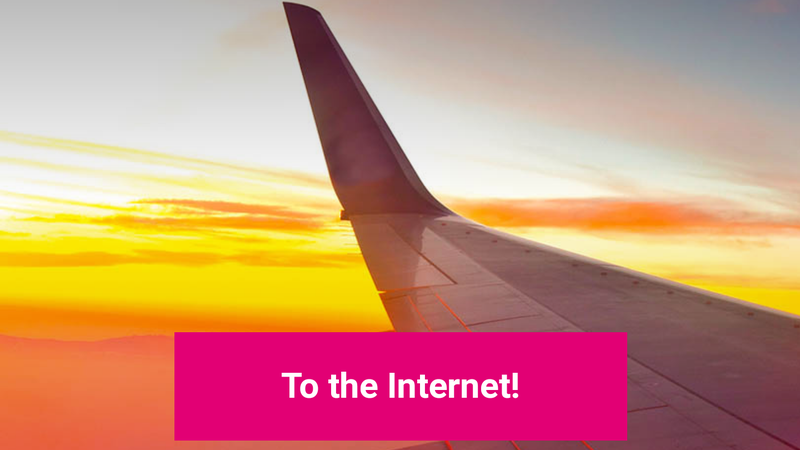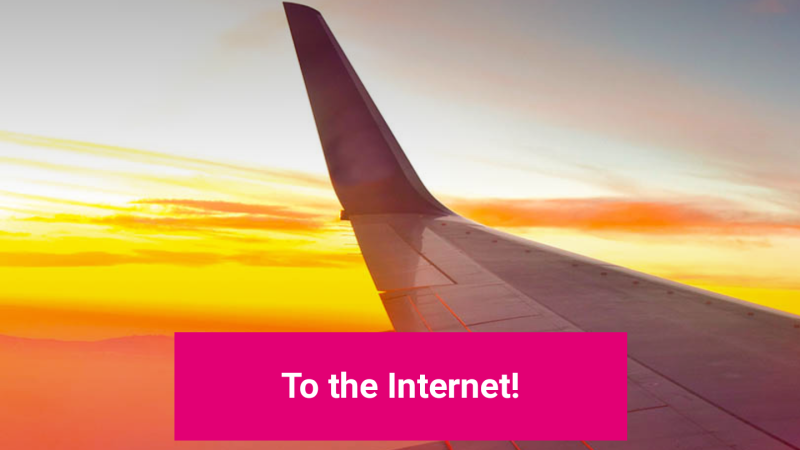
 Mile High WeekFlying the “friendly skies” is often hell, but it doesn’t have to be. It’s Mile High Week, and we’re investigating everything flight-related, from how to score cheap tickets to the best time to book, from how to fall asleep on a long-haul flight to how to win the perennial war over armrests. Wheels up.
Mile High WeekFlying the “friendly skies” is often hell, but it doesn’t have to be. It’s Mile High Week, and we’re investigating everything flight-related, from how to score cheap tickets to the best time to book, from how to fall asleep on a long-haul flight to how to win the perennial war over armrests. Wheels up.Paying for wifi on an airplane? You must be made of gold, because there’s no way I’m ever going to plunk down $10—or more—for a mere 30 minutes of internet time. At least, that’s what Gogo was charging on my recent Alaska Airlines trip. But thanks to a few clever workarounds (if I do say so myself), I was able to get more free internet time than I deserved. Here’s how.
Thanks, T-Mobile
Though Gogo inflight internet is outrageously expensive, T-Mobile has partnered up with Gogo to give all of its cellular subscribers a free hour of internet. That’s not a lot, I know, but we’ll address that part in a bit. (If your flight is only two hours long or so, that’s just enough time to mess around on your favorite website while you’re hovering above 10,000 feet.)
Advertisement

If you’re a T-Mobile subscriber, great! Enjoy your hour and skip forward to the next section when it runs out. If you’re on another carrier, however, you’re going to have to get a little tricky.
Advertisement
To confirm you’re a T-Mobile user, Gogo will ask you to verify your phone number before it gives you that free hour. When it does, start typing in random phone numbers until you magically stumble on a T-Mobile user. You’ll get your free hour and they’ll be none the wiser.
(I tested this by using the phone number for Lifehacker health editor Beth Skwarecki, and she didn’t receive any notifications, texts, or any other indication that I was “borrowing” her number for some wifi.)
Advertisement
This might be a slightly arduous process depending on your luck, but you surely know someone who uses “The Uncarrier.” Before testing this with Beth, I typed in random numbers and achieved success within five tries—not bad.
What happens when your hour runs out?
Your internet goes away. However, you can still use some messaging apps and send texts, so you won’t be cut of from the world forever during your flight—at least, that was the setup on my recent Alaska Airlines trip.
Advertisement

You’re probably pondering the obvious question: Why not log off the wifi, log back on, and use a different phone number to get an extra hour? At least, that’s the first thing I thought about, but Gogo’s setup is smart. You can clear your browser’s cache and cookies, for example, and you’ll be able to make it as far as the “enter a number” page. However, the service detects you’ve already been given a free hour and won’t let you get another one with a different number:

Advertisement
What I was able to figure out during my flight was that this “did you use it already” tool tracks your device by MAC address. That doesn’t really help you if you’re on an iPhone, since you have no way to change it. However, if you aren’t running Android Q, you should be able to use the Terminal Emulator app to change your Android device’s MAC address to anything you want—getting you another hour for free.
I’m on the Android Q beta, and Terminal Emulator was unable to change my MAC address when I tried it out. I still had one other trick up my sleeve, though—and, no, I wasn’t about to root my phone just to get free airplane wifi. Instead, I took advantage of a new Android Q feature, where the OS automatically randomizes your MAC address when you connect to new wifi networks.
Advertisement
This implementation isn’t perfect, as Android Q picks one random MAC address to use for that network, rather than changing it up each time you connect. In my case, I used my free hour of wifi on this dummy MAC address, and then I switched back to my device’s real MAC address by tapping the gear icon next to the wifi network’s name and finding the “Privacy” option in Network Details:

Advertisement
I finished up by logging off the Gogo wifi network, logging back on, and using a different T-Mobile number to get another free hour on my “new” Android phone.
What about your computer?
If you try to pull up Gogo’s wifi-access page from your laptop during a flight, you won’t see an option to get a free T-Mobile hour. Your laptop isn’t a mobile device, after all, but we can fix that.
Advertisement
I initially thought it would be enough to change Chrome’s user agent to make my MacBook appear as if it’s something it isn’t—an iPhone, for example. I was almost successful, too, but Gogo’s crafty checks deduced that I was still using a laptop:

Advertisement

With plenty more time to kill on my long flight, I tried a different method. I switched over to Firefox and inserted a new string in its about:config page that overwrote my user agent browser-wide. In other words:
- I typed about:config into my address bar
- I searched for “useragent”
- I right-clicked and added a new string, calling it
general.useragent.override - For the string value, I borrowed one from this site. I copied and pasted this entire chunk of text:
Mozilla/5.0 (iPhone; CPU iPhone OS 6_0 like Mac OS X) AppleWebKit/536.26 (KHTML, like Gecko) Mobile/10A5376e
Advertisement

- When I was done—to be safe—I loaded up Terminal on my MacBook and changed my device’s MAC address to one that only differed from my iPhone’s MAC address by a single digit (the final one). Though I doubt Gogo wifi deduces what a device is by anything found in its MAC address, this doesn’t hurt, and it was good practice for the spoofing I’d do later to get extra hours on my MacBook
- I then refreshed the Gogo wifi page in Firefox and was able to activate my free hour as if I was using a mobile device, which I was most certainly not.
- Finally, I deleted the user agent override so it wouldn’t mess up my other Firefox browsing.
Advertisement
After all that effort, I basked in my great reward:

Advertisement
Meh. Still, free wifi is free wifi—thanks again, T-Mobile!













